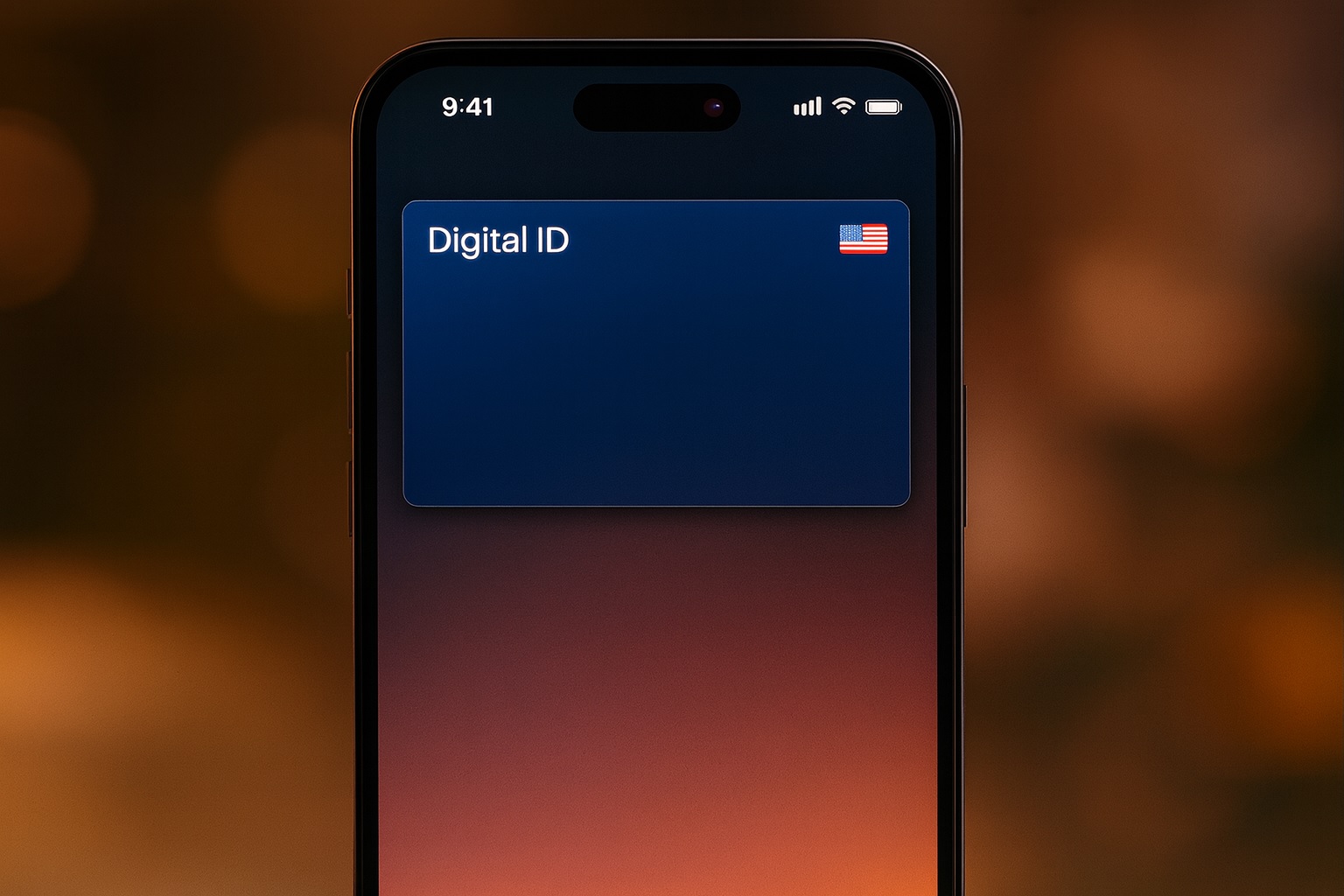- Digital Passport Coming: Apple has confirmed that U.S. iPhone users will “soon” be able to add a digital version of their passport to the Apple Wallet app [1]. The feature was reiterated by Apple Pay and Wallet VP Jennifer Bailey during a keynote at the Money20/20 conference in Las Vegas this week. Apple’s website likewise notes the delayed feature is “coming later this year” [2].
- Domestic Use Only (For Now): The digital passport ID will be accepted at select TSA airport checkpoints for domestic flights, providing an alternative to physical IDs [3]. However, it is not a replacement for a physical passport — international travel and border crossings will still require the physical document [4]. Apple emphasizes that the digital ID is REAL ID-compliant and secure and private [5], using biometric verification (Face ID/Touch ID) to protect user data.
- Builds on Digital IDs Rollout: This move builds on Apple’s existing digital driver’s license/ID program, which has rolled out in partnership with about 12 U.S. states and Puerto Rico so far – roughly one-third of all U.S. driver’s license holders [6]. Adding passport support takes Apple’s Wallet beyond payments and tickets into a broader digital identity platform. As Bailey put it, Apple’s goal is for the iPhone to hold “everything that is in your wallet,” from IDs to keys [7].
- Timing and Real ID Deadline: The announcement comes as new REAL ID federal rules are being enforced. As of May 2025, U.S. travelers must show a REAL ID–compliant license or a passport to board domestic flights [8]. Many state IDs still don’t meet these standards, so a digital passport on iPhone offers a timely workaround for travelers [9]. At TSA checkpoints that support digital IDs, passengers will be able to verify identity with their iPhone or Apple Watch instead of handing over a physical ID, potentially speeding up security lines.
- Google Got There First: Apple is actually playing catch-up in this arena. Google Wallet already introduced the ability to add U.S. passports as a digital “ID Pass” last year [10]. The TSA has been accepting digital IDs from Google Wallet in select airports, although — just like Apple’s implementation — digital passports cannot be used for international flights [11].
- No Set Launch Date, But Imminent: Apple has not given an exact release date, but the feature is expected in an upcoming iOS 26 update (possibly iOS 26.1 or 26.2) [12] [13]. The company’s iOS 26 preview page highlighted the digital ID capability, and Apple has begun seeding beta software – though as of the latest beta the passport feature wasn’t live yet [14] [15]. Apple’s messaging of “later this year” suggests it will go live before the end of 2025.
Apple Wallet to Carry Your Passport ID
Apple is on the cusp of turning the iPhone into a digital passport. “What if your phone could replace everything in your wallet?” Apple’s VP of Wallet Jennifer Bailey asked at the Money20/20 fintech conference [16]. She answered her own question with news that U.S. passports will soon be supported in Apple Wallet, alongside credit cards, transit passes, car keys, tickets and other digital credentials. “So really, everything that is in your wallet, we’ve been working to replace,” Bailey said, noting the company has been making “great, great progress” on that vision [17].
Bailey’s announcement is the first public confirmation from Apple that the digital passport feature is nearing launch, after being teased earlier in the year. Apple had initially announced at WWDC 2025 that iOS 26 would support “TSA-approved digital passports”, but the feature was delayed past the initial iOS 26 release [18]. On Apple’s official iOS 26 page, the passport-based Digital ID is listed as “coming later this year”, indicating it will arrive via a software update rather than having been included on day one [19]. It’s not yet clear if this will require downloading a full iOS update (e.g. iOS 26.1) or if it could activate via a server-side update [20], but the timing appears imminent.
When it goes live, the new feature will allow iPhone users to create a verified digital ID from their U.S. passport right in the Wallet app [21]. According to Apple, you will scan your physical passport, then go through a secure identity verification process – similar to how Apple’s driver’s license integration works. This involves using your iPhone’s camera to scan the passport’s data and performing a facial authentication step (moving your head or face as instructed, and taking a selfie) to prove that you are the owner of that ID [22]. The digital passport credential is then cryptographically signed and stored in your Apple Wallet, accessible on your iPhone and Apple Watch.
An ID for Domestic Travel, Not International Trips
The digital passport in Apple Wallet is intended for convenience in domestic air travel, not as a full replacement for the physical booklet. Apple and government authorities are making it clear that you’ll still need your physical passport for any international flight or border crossing [23]. In other words, the Wallet-stored passport will function as a U.S. TSA-compliant ID – essentially a high-tech substitute for showing a driver’s license or passport at airport security within the United States.
“While not a replacement for your physical passport, digital ID can be used for domestic travel and at supported TSA checkpoints,” an Apple spokesperson explained when previewing the feature [24]. The digital ID will contain the necessary data to verify your identity and citizenship status to TSA officers via secure electronic scanning. Participating TSA checkpoints (at select airports) have Credential Authentication Technology that can read the encrypted ID from your device, often by simply tapping your iPhone or Watch at the security podium. This means travelers may be able to speed through airport ID checks without fishing out a wallet or handing over a document [25].
For any international travel, however, your physical passport remains essential. The digital version will not be accepted for crossing borders or international flights [26]. This limitation is the same for Google’s digital ID and any state-issued mobile driver’s license (mDL) as well – they are currently valid only for in-country identity verification. The digital passport is best seen as a companion to, not a replacement for, the physical passport – useful for domestic flying convenience and as a backup form of ID, but not (yet) a globally recognized travel document.
Why the Timing is Right: REAL ID and TSA’s Digital Push
Apple’s passport-on-iPhone feature comes at a pivotal moment for air travelers. Starting May 7, 2025, the U.S. federal government began enforcing REAL ID requirements for domestic air travel [27]. This means that a standard driver’s license without the REAL ID star (indicating enhanced security standards) is no longer sufficient to pass through TSA checkpoints. Travelers now must present either a REAL ID–compliant license/ID or an alternative like a passport. The problem: many Americans still carry older licenses that aren’t REAL ID compliant, and some have been slow to obtain the updated IDs. This looming issue has already caused concerns about airport bottlenecks and travelers being turned away.
The digital passport ID offers a timely solution for those caught in that transition. If you don’t have a REAL ID license, you can use your valid U.S. passport to fly domestically – and with Apple Wallet, that passport can be presented digitally on your phone [28]. Essentially, Apple is giving iPhone owners a tech-forward way to meet the new ID requirements. By partnering with the TSA, Apple is ensuring that its digital IDs will be recognized at security checkpoints (TSA has been testing and rolling out digital ID support over the past two years). Bailey noted that integration with TSA will enhance “speed, convenience, and security” for travelers, as they can verify their identity quickly without handing over physical documents [29].
Importantly, the TSA has already warmed to the concept of mobile IDs. Google Wallet introduced support for digital driver’s licenses and passports in 2024, and the TSA is accepting those Google “ID Pass” credentials at certain airports [30]. For example, a traveler with an Android phone can load their state ID or passport into Google Wallet and use that at an ID scanner in participating airports. Apple was not far behind – it launched support for digital driver’s licenses in Wallet starting in 2022, expanding to more states gradually. According to TechCrunch, Apple’s Wallet ID program is live in 12 states plus Puerto Rico so far [31], covering roughly a third of U.S. IDs. Jennifer Bailey said the passport feature “builds on the progress we’ve made with state-issued IDs,” referencing those state partnerships [32]. In short, Apple has been laying the groundwork with digital driver’s licenses, and now the passport integration is the next big step.
The convergence of these trends – the REAL ID deadline and the maturation of digital ID technology – sets the stage for Apple’s digital passport. Government agencies have signaled openness to digital IDs as long as they meet security standards. In fact, the Department of Homeland Security and TSA gave explicit approval for mobile IDs, and have been working with Apple and Google in pilot programs [33] [34]. So Apple’s timing allows it to ride the wave of digital identity adoption just as it becomes a practical necessity for travelers.
How Secure is a Digital Passport on iPhone?
Whenever the topic of digital identification comes up, security and privacy are top of mind. Apple is stressing that the passport in your Wallet will be highly secure and private. The digital passport credential is stored in the Secure Element of the device (the same hardware enclave that stores Apple Pay cards and Face ID data). Apple says the Digital ID feature is compliant with REAL ID standards for security [35], meaning it meets the federal criteria for authentication and protection against forgery or misuse.
When adding a passport or driver’s license to Wallet, the process itself involves multiple layers of verification. As described by Apple, users will scan their physical ID, then complete a biometric liveness check (moving your head or face as prompted) and take a selfie, which is matched to the ID photo [36]. This is to prevent someone from adding your ID to their phone. After that, the issuing authority (e.g. your state DMV or the passport agency) must approve the addition – meaning there’s a backend check with the government database before the digital ID becomes active [37] [38]. This multi-step onboarding is designed so that only the rightful ID owner can digitize their document.
Once stored in Apple Wallet, your ID data is encrypted and cannot be accessed without biometrics (Face ID or Touch ID) each time you want to use or share it [39]. When you do present it at a TSA checkpoint or to a supported app/business, you have to authorize the transfer of data, and you see exactly what information is requested and transmitted. Notably, Apple and the issuing government agency do not get to see when or where you use your digital ID – those transactions are private between you and the verifying party [40]. This approach reflects Apple’s broader privacy stance (similar to how Apple Pay doesn’t reveal your card number or transaction history to Apple).
Experts in digital identity say these systems can actually enhance privacy because you often share less information than you would with a physical ID. For example, at an age check, the digital ID can simply confirm “21+” without revealing your actual birthdate or address. Apple has indicated the Wallet ID will support such selective disclosure for age or identity verification in apps and stores [41]. And if your iPhone is lost, the digital passport is protected by device passcode/biometrics, plus you can remotely wipe your device via Find My – so a thief cannot use your ID. Still, users will need to be vigilant with their Apple ID security and iPhone access, just as they are with mobile payment cards.
Apple’s Expanding Identity Ambitions
Adding passports to Wallet is part of Apple’s expanding strategy in personal identity management, which goes hand-in-hand with its services ecosystem. By making the iPhone an indispensable tool not just for payments and tickets but also for government-issued identity, Apple deepens the “stickiness” of its ecosystem. Industry analysts note that if your driver’s license, school ID, and now passport are all conveniently saved in your iPhone, you’re even less likely to switch to a competing device [42]. “We like Apple’s efforts to stickify its ecosystem,” one market researcher quipped, pointing out how services like Wallet tie customers more tightly into Apple’s platform [43].
Beyond the business angle, this move underscores a broader tech trend: our smartphones are steadily absorbing functions that wallets and even governments have traditionally handled on paper. “Apple’s forthcoming passport-linked Digital ID initiative underscores its ambition to make the iPhone central to personal identity in the digital era,” observed tech outlet Tekedia, highlighting how the company is positioning itself at the center of digital credentials [44]. In Apple’s vision, your iPhone or Apple Watch becomes the one-stop repository for everything that identifies you – not just credit cards and loyalty cards, but licenses, passports, keys, tickets, medical records, and more.
Of course, Apple is not alone in this ambition. Google, through Android and Google Wallet, has its own digital ID push. Various governments and startups are also developing mobile ID solutions. But Apple’s advantage is its tight integration of hardware, software, and services – the same advantage it used to popularize mobile payments with Apple Pay. If Apple Wallet’s passport feature is smooth and widely accepted, it could accelerate public adoption of digital IDs in general.
What Comes Next
All eyes will be on Apple’s next iOS updates for the official rollout of digital passports. The company is expected to detail the feature’s availability in an upcoming software release announcement. iPhone users with a valid U.S. passport will likely be able to add it to Wallet with a few taps and scans, then start using it at participating airports. Initially, usage will be limited to certain TSA checkpoints (travelers should look for signage indicating digital ID is accepted) [45]. Over time, we may see more airports and federal facilities embrace digital ID as the technology proves itself.
Apple will also have to navigate the regulatory landscape. Each U.S. state has its own process for digital driver’s licenses, and adding passports involves coordination with the U.S. State Department and Homeland Security. The fact that Apple has gotten the green light (and had a VP announce it on stage) suggests those government partnerships are well underway. Jennifer Bailey’s presence at Money20/20 – a finance and identity industry forum – signals Apple’s intent to work closely with authorities and industry on Wallet’s expansion [46].
In the coming months, expect Apple to publish guidelines or support pages for how to use the passport feature, much like it has for driver’s licenses. We’ll learn which iPhone models and iOS versions are supported (likely iPhone 8 or later, given prior requirements [47]) and any nuances like needing to have Face ID enabled, etc. Apple will also likely publicize the convenience factor: using your Apple Watch at TSA, for instance, to flash your ID while your phone stays in your pocket.
Finally, the launch of digital passports on iPhone could open the door to more digital ID uses. Apple has mentioned that beyond travel, the Wallet ID could be used for things like age verification at bars or apps, identity checks for car rentals, and more [48]. With a passport on file (which is a very high-assurance identity document), such use cases become even more compelling. Imagine checking into a hotel with just your phone (digital ID + digital key), or proving your identity for an online notarization via your iPhone. Apple is likely eyeing all these possibilities as it marches toward an era where the iPhone fully replaces the traditional wallet.
For now, the takeaway is: If you’re an iPhone user, you may soon have one less thing to carry when you fly. The next time you head to the airport for a domestic trip, your boarding pass and your ID could both be neatly sitting in Apple Wallet on your device. “Everything in your wallet” might indeed end up being in your phone [49] – and your passport is about to join that digital future.
Sources
- Joe Rossignol, “Apple Says U.S. Passport Feature on iPhone is Coming Soon,” MacRumors, Oct. 27, 2025 [50] [51].
- Jason Hall, “iPhone Users Will Soon Have Real ID Alternative,” iHeartRadio News (via WWDC 2025 coverage), Jun. 13, 2025 [52] [53].
- Apple Inc., iOS 26 Preview – Digital ID in Wallet (Apple.com official site) [54] [55].
- TechCrunch via Slashdot, “Apple Says US Passport Digital IDs Are Coming to Wallet ‘Soon’,” Oct. 27, 2025 [56] [57].
- Masha Borak, “Apple adding US passports to Wallet app,” Biometric Update, Sep. 24, 2025 [58] [59].
- William Gallagher, “Apple Wallet’s expansion into US passport support nears launch,” AppleInsider, Oct. 27, 2025 [60] [61].
- Samuel Nwite, “Apple to Introduce Passport-Linked Digital IDs in Wallet…,” Tekedia, Oct. 28, 2025 [62] [63].
References
1. appleworld.today, 2. appleworld.today, 3. appleworld.today, 4. appleworld.today, 5. www.macrumors.com, 6. www.tekedia.com, 7. appleinsider.com, 8. www.tekedia.com, 9. www.tekedia.com, 10. www.biometricupdate.com, 11. www.biometricupdate.com, 12. www.macrumors.com, 13. appleinsider.com, 14. www.biometricupdate.com, 15. appleinsider.com, 16. appleinsider.com, 17. appleinsider.com, 18. apple.slashdot.org, 19. appleworld.today, 20. www.macrumors.com, 21. www.tekedia.com, 22. www.biometricupdate.com, 23. appleworld.today, 24. country.iheart.com, 25. appleworld.today, 26. appleworld.today, 27. www.tekedia.com, 28. www.tekedia.com, 29. www.tekedia.com, 30. www.biometricupdate.com, 31. www.mactech.com, 32. www.tekedia.com, 33. country.iheart.com, 34. www.biometricupdate.com, 35. www.macrumors.com, 36. www.biometricupdate.com, 37. learn.wallet.apple, 38. learn.wallet.apple, 39. learn.wallet.apple, 40. learn.wallet.apple, 41. www.macrumors.com, 42. pro.thestreet.com, 43. pro.thestreet.com, 44. www.tekedia.com, 45. learn.wallet.apple, 46. appleinsider.com, 47. learn.wallet.apple, 48. www.macrumors.com, 49. appleinsider.com, 50. www.macrumors.com, 51. www.macrumors.com, 52. country.iheart.com, 53. country.iheart.com, 54. www.apple.com, 55. www.apple.com, 56. www.mactech.com, 57. www.mactech.com, 58. www.biometricupdate.com, 59. www.biometricupdate.com, 60. appleinsider.com, 61. appleinsider.com, 62. www.tekedia.com, 63. www.tekedia.com


